#Julia in Utah 2023
Text
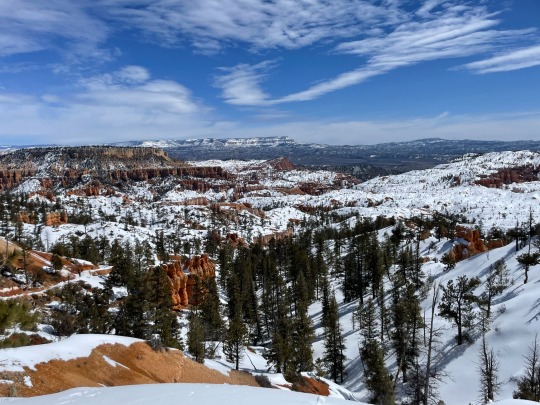

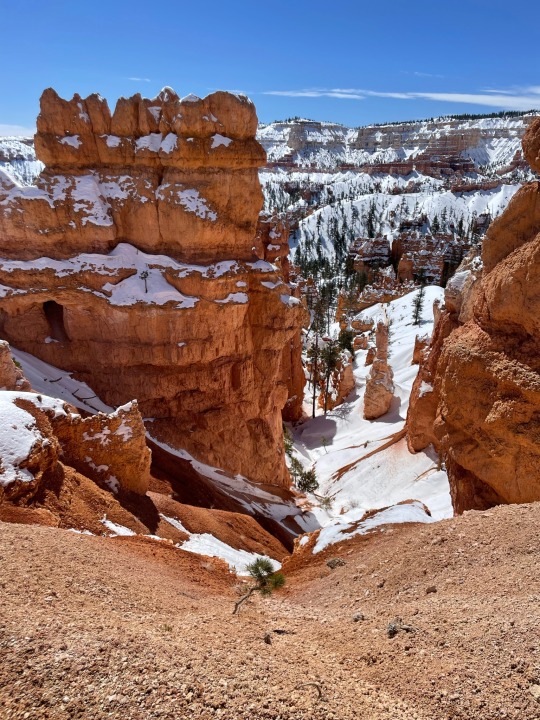

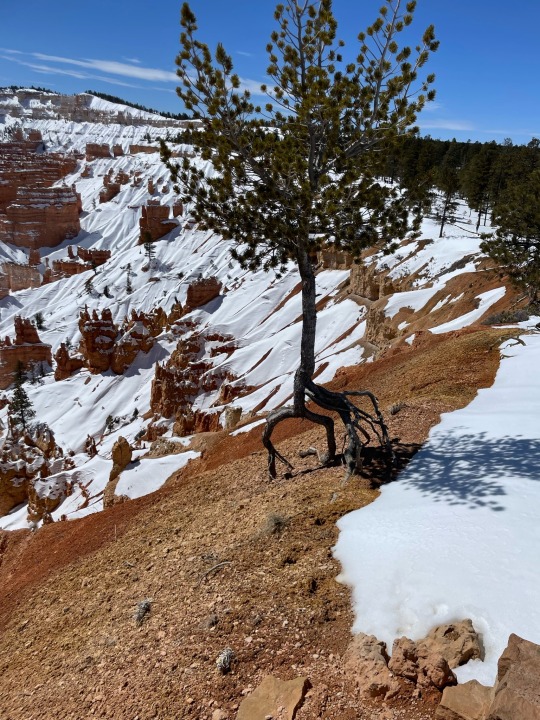
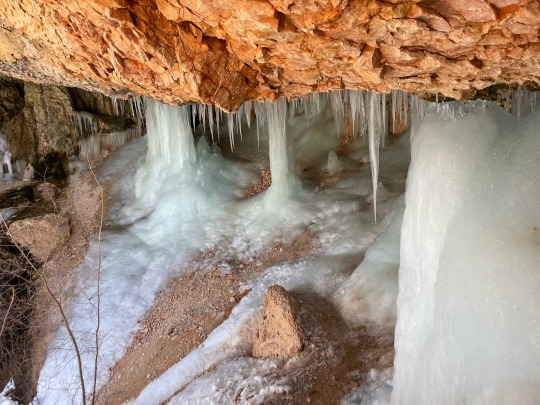
bryce canyon ☀️ ❄️ 🌲
#did not enjoy this as much as Zion bc it was colder and snowier so more slippery and also higher altitude so head hort#I think it would have been better to visit later in the year. but it was gorgeous! I don’t think the pics of the canyon really fully capture#the view and the colors#Julia in Utah 2023
16 notes
·
View notes
Text
Highlights of 2023
Going to EMP every day of the first week of January, and hearing, "부르심을 위한 포기" - which was exactly what I needed in the season of A
Hearing what I needed to pray for this year - "to be completely satisfied in Jesus, and Jesus alone.
Esther's bachelorette to Fort Lauderdale, FL
Turning 29
Annual boujee birthday dinner with Gloria and Yaegene. And the most amazing experience at Causa + Amazonia
Running and biking
Obeying the Lord, despite how much it hurts
Taking singing class, for the first time ever! And how difficult singing is!
Donating blood for the first time
Centreville CG and meeting Christine Y. <3
Sending Yerin to Europe, and then visiting her in my first European trip to France!!!
Esther getting married!
Moving into Main Line Casa, and loving all my girls
A lot of NY trips, starting with dog sitting Alanis at Josie's
Reunions with Jin, Bo and David
Many favorable fashion outfits this year, thanks to NY
Most expensive meal of my life treating dad for Father's Day at Sushi Nakazawa
So much orange wines
Buying my first record player, and jumping into the vinyl game
A lot of hot yoga
Feeling a bit of a funk still, and checking out different churches, which was God's calling to get into Project Belong
First family trip outside of East Coast, to Arizona/Utah/Nevada
Taking pottery class, and absolutely failing at it
Salsa dancing class, and sweatingggg
The most perfect weekend at the farm house at Julia's
CT trip to see Jenny and Ben
Can't say enough about my beautiful housemates and the patterns of our lives: prayers and praise
Letting go, and honoring what was then my best relationship by writing a letter to Alice
Kenya 2023, which was absolutely my best medical mission trip to date
Extremely thankful for Jesus who answers all of my prayers, and allowing me to be completely satisfied in Him. And turning what I thought would be the worst year, to be my best year
Concerts/Performances: 1) Maggie Roger at Anthem, 2) Into the Woods at Kennedy Center, 3) Epik High at Warner Theatre, 4) Sylvan Esso at Atlantis, 5) Twelfth Night at Shakespeare Theatre, 6) Moulin Rouge at Kennedy Center, 7) Jacob Collier + NSO at Kennedy center, 8) Cigarettes after Sex at the Anthem, 9) slchld + wave to earth at Howard Theatre, 10) Evita at Shakespeare Theatre, 11) Del Water Gap at 9:30 club, 12) Jon McLaughlin at the Birchmere
0 notes
Text
Expansion Draft Step 3: Mock Draft
So here’s how I think it would go (or how it would go if I were in charge of every single team in the league).
Bay selects Sam Hiatt from the Reign
Reign protects Elyse Bennett
Utah selects Sarah Griffith from Chicago
Chicago protects Jenna Bike
Bay selects Ryanne Brown from the Reign
Reign is out of the draft
Utah selects Amanda Kowalski from Chicago
Chicago is out of the draft
Bay selects Kyra Carusa from Wave
Wave protects Sofia Jakobssen
Utah selects Thembi Kgatlana from Louisville
Louisville protects Paige Monaghan
Bay selects Tyler Lussi from North Carolina
North Carolina protects Tess Boade
Utah selects Julia Lester from Louisville
Louisville is out of the draft
Bay selects Rachel Hill from Wave
Wave is out of the draft
Bay selects Katelyn Rowland from North Carolina
Draft is over
I feel pretty comfortable with the first two selections (although Griffith and Bike could be swapped), but then Bay’s second selection is where it really could go anywhere - I think there’s a ton of good forwards available to them from teams that Utah doesn’t get to pick from, so they would probably go for an outside back or maybe a goalkeeper in this round, but that could be Ryanne Brown or Jill Aguilera, or even Laurel Ivory or Maia Pérez. If they were to take Aguilera instead, I would say that Utah probably takes Shae Homes as their second choice and then things generally stay the same from there, and if Bay were to take a goalkeeper from Reign instead of an outside back, they would probably then take Haley Hopkins or maybe Brianna Pinto as their second choice from North Carolina.
Two things worth noting: first, pretty much across the board, if a player that I expect to be the extra protected player doesn’t get that designation, I think they will be taken as the second drafted player. Second, I think the decision not to protect Thembi Kgatlana initially is baffling, unless a) she wanted to leave, or b) the approach was simply to determine protected/unprotected based on how many regular season minutes each player played in 2023 to reduce locker room tensions.
0 notes
Text
By Julia Conley
Common Dreams
Aug. 17, 2023
Eleven groups united on Thursday, "calling on lobbyists to pick a side in the climate fight."
Weeks after a public interest watchdog unveiled the deep ties the fossil fuel industry maintains to numerous industries in the U.S.—with universities, technology firms, and insurance companies employing many of the same lobbyists as the oil and gas sector—nearly a dozen climate justice groups on Thursday issued a call for governments and institutions across the country to "fire" their fossil fuel lobbyists.
F Minus, the research group behind a database released last month showing that more than 1,500 lobbyists have worked both for fossil fuel companies and local governments, schools, and other businesses, was joined by organizations including 350.org, Food & Water Watch, and the Rainforest Action Network (RAN) on Thursday in issuing the demand.
The groups warned that lobbyists employed by companies like Amazon and State Farm; cities including Minneapolis and Park City, Utah; and institutions such as Omaha Public Schools and the University of Washington are "playing both sides of the climate crisis by lobbying on behalf of oil, gas, and coal companies at the same time they are lobbying on behalf of communities and businesses being harmed by the climate crisis."
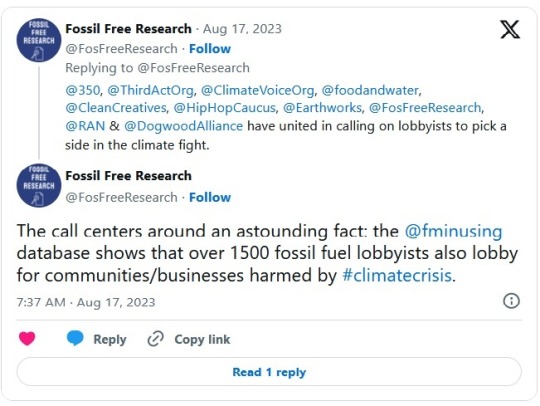
The lobbyists in question, they said, must choose between taking money from the industry international scientists agree is causing planetary heating, extreme weather, and other effects of the climate emergency, or working on behalf of the nation's communities.
"Hiring a fossil fuel lobbyist is radically at odds with fighting the climate crisis," said James Browning, executive director of F Minus. "It's time to talk to these lobbyists in a language they understand—money—and force them to choose between getting paid to work for the perpetrators of the climate crisis or its victims."
The group revealed last month that universities which have bowed to significant pressure in recent years to divest from fossil fuels are still employing lobbyists that work to promote the pollution-causing industry's interests.
Johns Hopkins University, for example, divested from coal in 2017 but still employs lobbyists for NRG Energy and Holcim Participation, which both have "substantial coal interests."
"Young people will live with the climate crisis the longest and experience some of its worst impacts," said the groups Thursday. "Yet hundreds of colleges and public school districts employ lobbyists whose work on behalf of fossil fuel companies is making the crisis worse. We call on educational institutions to cut ties with these lobbyists."
The groups also noted that a number of cities whose residents are at risk of climate impacts continue to work with fossil fuel lobbyists. Minneapolis' plan to cut city emissions by 80% by 2050 is at odds with the fact that it shares a lobbyist with Enbridge, the Canadian oil company whose pipeline in Wisconsin was ordered to be partially shut down in June due to its risk of causing an environmental disaster on tribal land.
Minneapolis and other cities that employ fossil fuel lobbyists "must end those relationships now—and throw all resources behind lobbying 100% for climate solutions and climate policy progress," said Deborah McNamara, co-executive director of ClimateVoice, which also signed the statement.
"The imperative to act on behalf of climate action and climate policy progress is clear," she added. "At every turn we must be proactive in building new systems, calling out the misalignments in our current systems, and ensuring that all of our activities align with climate leadership and action."
The groups also noted that Amazon has employed fossil fuel lobbyists in 27 states while signing onto an international industry pledge to reach net-zero carbon emissions by 2040, and insurance companies including Liberty Mutual, Berkshire Hathaway, and State Farm work with lobbyists in dozens of states—even as the insurance industry has increasingly withdrawn from operating in states and communities facing extreme weather events.
"Liberty Mutual is sharing lobbyists with the fossil fuel industry and it shares a board member with Exxon," said Mary Lovell, energy finance campaigner at RAN. "They deny coverage for homeowners and businesses while providing coverage for fossil fuel projects in the same areas."
The lobbyists' ties to universities, cities, and companies relied on by millions of Americans enable them to "cloak a radical pro-pollution agenda in respectability," said the groups.
"All of these organizations and their constituents face a harrowing climate future unless we do more to check the power of the fossil fuel industry," they added. "Fire its lobbyists."
Our work is licensed under Creative Commons (CC BY-NC-ND 3.0). Feel free to republish and share widely.
1 note
·
View note
Text
0 notes
Text
Here they come!
Meet the Incoming Class
PHD/Black Mountain Institute Fellows
Heather Peterson (Fiction)
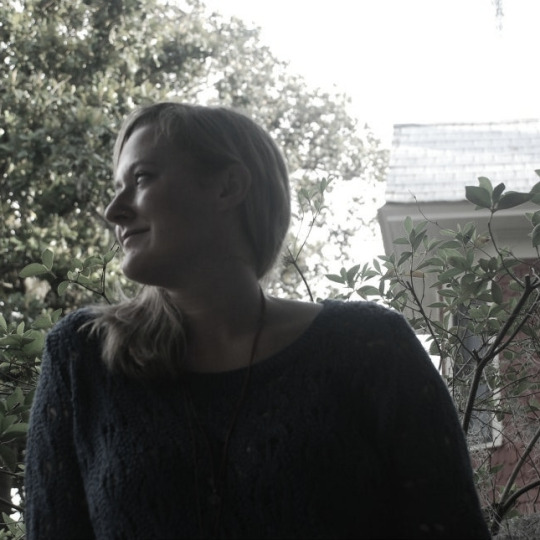
Heather Wells Peterson earned her MFA in Fiction from the University of Florida. Since then, she has worked as an adjunct writing instructor, a book doula, an editor, and in tech. Her fiction and nonfiction has appeared in American Short Fiction, The Rumpus, Subtropics, and Lit Hub, among others. She's looking forward to moving from Los Angeles to Las Vegas with her partner, Bredt, and her dog, Nelson. You can learn more about her at https://www.heatherwellspeterson.com/.
Fiction MFA
Sabrina Shie

Sabrina Shie is a writer from the Bay Area. Formerly a software engineer, she's given up and is having a lot more fun wrangling her internal dialogues into readable fiction. She also enjoys performing improv and stand-up, sometimes to live audiences, sometimes to her cat.
Per Loufman
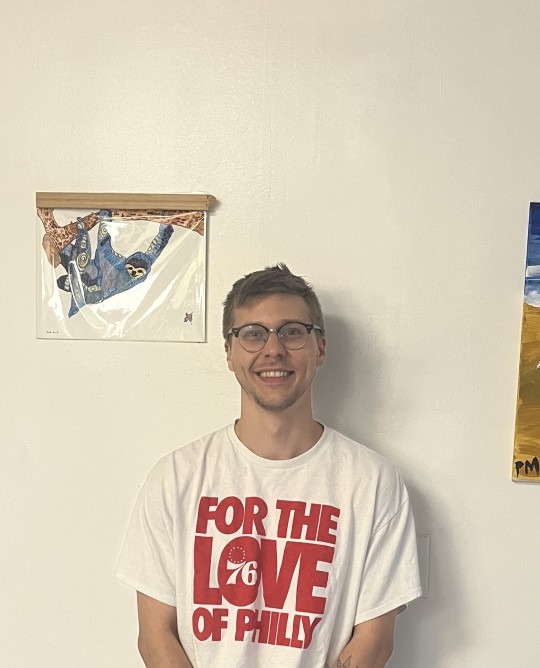
Per Loufman is moving to Las Vegas from Philadelphia, PA, where he was born and raised and received a degree in Creative Writing. He has spent the last seven years working in restaurants throughout the city. His fiction often takes place in real worlds full of different things like loss, addiction, and love.
Julia Lu
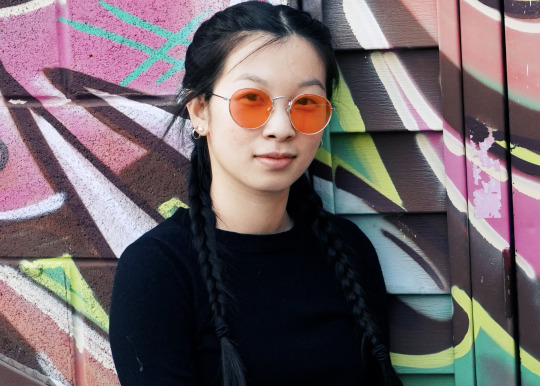
Julia is a fiction writer born and raised in Houston, Texas. She studied film production in college and is currently living in Chicago. Julia enjoys cooking and baking, taking walks, and picture books. Her favorite season is summer.
Ahmed Naji

Ahmed Naji is a writer from Egypt currently exiled in Las Vegas. In 2016 he was sentenced to two years for obscenity and disturbing public morals because of his novel “Using Life”, After a year in prison, he was able to sneak out of the country and immigrate to the USA in 2018. His literature fiction works include the novels “The happy ends” (2023) , “and tigers to my room” (2020), “Rogers” (2007), and a collection of short stories, “The Mystery of the missing liver” (2016). His work has been translated into several languages, including English, French, Italian and more. His coming book “Rotten Evidence”, which chronicles his time in prison, is due out in September (2023) by McSweeney's. In addition to being a writer, Ahmed Naji is also a journalist, documentary filmmaker, and official criminal. Throughout his career, he has received several awards, including Best Short Documentary Film at the Washington DC Film Festival for his documentary "For Vegas" (2023), a Dubai Press Club Award for the Best Culture Article (2011), and a PEN/Barbey Freedom to Write Award (2016).
Brandon Cunningham
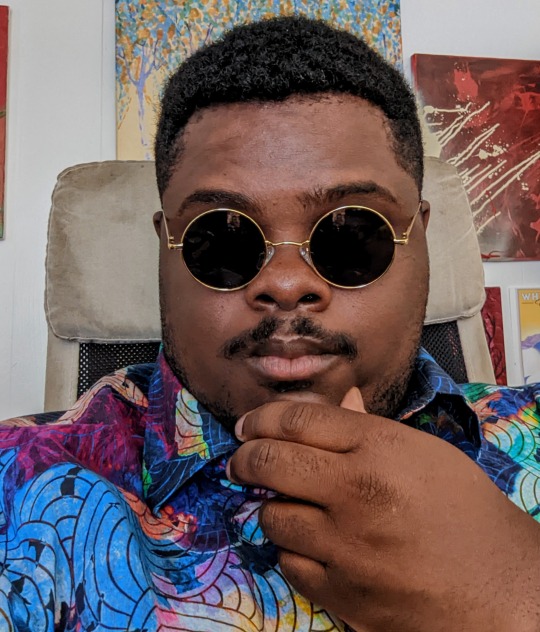
Branden Cunningham was born, raised and educated in the silver state. He went into activist work around environmental issues and spent close to eight years in that arena before changing gears to work two years on criminal justice reform. He brings his decade of activist work to his writing.
Poetry MFA
Jenna Farhat

Jenna Taha Farhat is a poet, journalist, and Arabic interpreter from Wichita, Kansas. Her journalism has appeared in the Miami New Times, ArtBurst Miami, The Sun News, the Wichita Eagle, and other publications. She earned a BA in creative writing from Wichita State University.
Ezra Moore

Ezra is a Vegas native with restless legs and always-full hands. Among other things, they currently work in marketing for non-profits. Despite the long hours, it's the most fulfilling job they've had. They're fresh out of UNLV with their Bachelor's in English, but they love the writing community enough to stay for another three years.
Alex Farhat
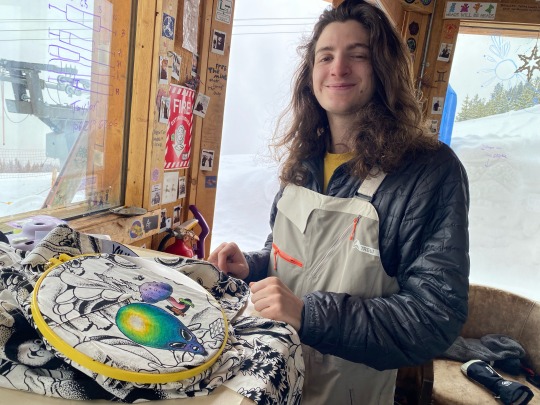
Alexander Farhat is originally from Dallas, Texas, but has lived in places across the U.S. from bustling metropolitan cities to rural towns. He earned his BA in English from WFU and now finds himself relocating to Las Vegas to pursue an MFA in poetry.
Lauren Gleave
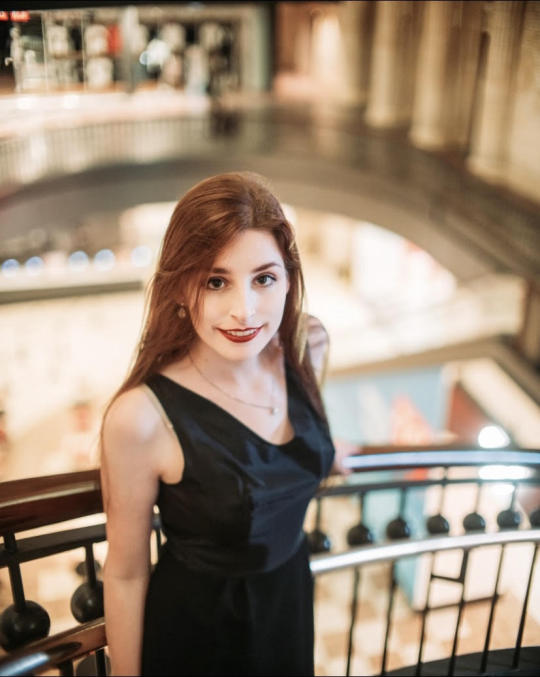
Lauren Gleave is a poet from Utah, where she earned her B.A. in health, society, and policy from the University of Utah. Her work often explores identity as it interfaces with religion, mythology, and folklore. Other than writing, her great loves in life are vintage clothing, old houses, and new people.
Polly Llewellan
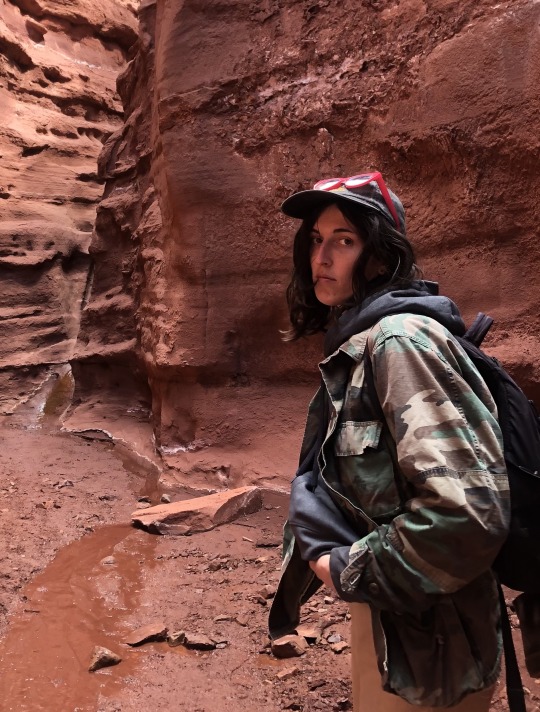
Polly Llewellyn is from rural Utah and lives in Salt Lake City. She likes pretty music and spiders. She spent the last five years working at the city library but is now at the front desk of a fertility clinic, where she steals free time to research the first world war. Polly is excited to move past the heat exhaustion she suffered in years past while selling lemonade at the Las Vegas San Gennaro festivals and discover a new side to the city.
Non-Fiction MFA
Tracie Williams

Tracie Chavonne, a Chicago Native, made her way to Las Vegas in 2020 to escape California. With her career as a flight attendant in jeopardy, she decided to complete her undergraduate degree after a fifteen-year hiatus from academia. Having received her Bachelors of Arts in English with a Summa Cum Laude distinction in the Spring of 2023 from the University of Nevada, Las Vegas, she has set her sights on continuing her education, pursing college professorship, deepening her relationship with writing, and creating a successful and lucrative career as an author by enrolling in the MFA Creative Writing Program in UNLV.
Sada Malumfashi

Sada Malumfashi is a writer and cultural curator from Nigeria. He curates the Hausa International Book and Arts Festival (HIBAF), a crisscross festival of arts and language by and for African creatives in an indigenous language. His writings have appeared in Brooklyn Rail, Akademie Solitude, Olongo Africa, The Republic, Lolwe, Bakwa Magazine, Transition Magazine and New Orleans Review. His works have explored Hausa feminist writings and how censorship, religion and conservatism affect the representation of queer lives and relationships in Hausa literature inflected and influenced by local conditions and cultural nuances.
1 note
·
View note
Text
COVID Survivors’ Blood Plasma Is A Sought-After New Commodity
Diana Berrent learned she had tested positive for COVID-19 on a Wednesday in mid-March. Within a day, she had received 30 emails from people urging her to donate blood.
Friends and acquaintances, aware of her diagnosis, passed along a pressing request from New York’s Mount Sinai Health System, one of the first centers to seek plasma, a blood component, to be used in a therapy that might fight the deadly disease. Berrent, 45, said she immediately recognized the need for the precious plasma — and the demand that would follow.
“When I saw that email going around, I saw what was going to happen in the landscape,” said Berrent, a photographer and mother of two who lives on Long Island. She went on to found Survivor Corps, a grassroots clearinghouse that connects people who have recovered from COVID-19 with organizations eager to collect their blood.
“What I saw was going to emerge was a free market where survivors were a commodity.”
Nearly two months later, Berrent’s prediction is coming true. The coronavirus has infected more than 1.2 million people in the U.S., and now government scientists, academic researchers and for-profit pharmaceutical firms all are scrambling for blood plasma from COVID-19 survivors in hopes of developing a range of potential treatments.
Email Sign-Up
Subscribe to KHN’s free Morning Briefing.
Sign Up
Please confirm your email address below:
Sign Up
In Minnesota, a program coordinated by the Mayo Clinic has collected plasma from more than 12,000 COVID survivors for transfusion into more than 7,000 gravely ill patients, the result of a massive public appeal led by government leaders and nonprofit groups like the Red Cross.
Meanwhile, for-profit companies that typically pay $50 per donation of plasma used in other lifesaving therapies are advertising aggressively — and significantly bumping up their rates for COVID donors.
In Utah, John and Melanie Haering, who contracted COVID-19 aboard the ill-fated Diamond Princess cruise ship, received gift cards worth $800 after making two donations apiece at a Takeda Pharmaceuticals BioLife Plasma Services center. BioLife runs several of the more than 800 paid-plasma collection sites in the U.S., part of an industry that produces plasma protein therapies used to treat rare, chronic conditions such as hemophilia and in medical emergencies.
John and Melanie Haering contracted COVID-19 aboard the cruise ship Diamond Princess. BioLife, a paid plasma collection site, gave the Haerings gift cards totaling $800 for donations of their blood plasma — to be used for possible therapy for those battling the disease.(Courtesy of the Haerings)
“Given the urgency and importance of collecting convalescent plasma from the small population of recovered COVID-19 patients, BioLife is currently offering an added incentive for the first two donations from recovered COVID-19 patients,” Takeda spokesperson Julia Ellwanger said in an email.
The money was “a nice surprise” for the Haerings, though they said they were motivated more by the opportunity to prevent others from suffering.
“If we could help anybody, we’d go every day,” said John Haering, 63, a retired railroad manager who spent two weeks in a hospital in Japan after testing positive for the virus.
Donors like Berrent and the Haerings are needed to supply the building blocks of potentially lifesaving treatments. Rich with antibodies, convalescent plasma from COVID-19 patients is being tested as a possible therapy to promote recovery in people who are critically ill with the disease.
It’s also being collected to create a concentrated antibody serum known as hyperimmune globulin that may prevent or halt infection in the future. Similar products are used to treat rabies and illnesses like infant botulism. If plasma from COVID-19 donors is shown to halt the disease, coming up with an antidote could offer companies the prospect of making millions of dollars.
And there’s the possibility of a third treatment, monoclonal antibody therapy, which would use antibody-producing cells from high-antibody donors to create lab-produced molecules to fight the disease.
All three therapies are promising, but all three require human blood plasma, said Dr. Michael Busch, a professor of laboratory medicine at the University of California-San Francisco and director of the Vitalant Research Institute, one of the largest blood center-based transfusion medicine research programs in the U.S.
“At some level, they’re all competing with the regular blood banks like mine,” Busch said.
Only a fraction of those infected with COVID-19 have recovered sufficiently to donate, though more are eligible every day. But as demand for donors has grown, so has the need to wrangle the supply, ensuring that competition for plasma doesn’t undercut the larger mission, said Dr. Michael Joyner, who heads the Mayo Clinic program.
“We’re going to get it all worked out,” he said. “It’s in everybody’s enlightened self-interest to do this in an intelligent way.”
To avoid what Joyner described as a “range war” for COVID-19 plasma, he’s spearheading an effort that calls for unprecedented collaboration to distribute separate streams of plasma among producers of therapies in a global market estimated to reach $35.5 billion by 2023.
“It’s like the oil market,” he said. “You send oil that needs one type of refining to one market and oil that needs another type of refining to another market.”
His plan — floated last month to a group that included representatives from philanthropic organizations along with executives from for-profit and nonprofit blood collectors — relies in part on blood plasma from up to 10,000 Hasidic women in New York City, where the Orthodox Jewish community has been hit hard by the disease.
Tens of thousands of people have fallen ill with the virus in the city’s Hasidic neighborhoods, and more than 700 have died. In recent weeks, thousands of men in the community who have recovered from COVID-19 have rushed to donate plasma. Chaim Lebovits, 45, who has helped organize the effort, said the donations are an act of faith.
“We have an obligation to protect and save lives,” Lebovits said.
So far, however, many women in the Hasidic community have been unable to participate. Hasidic families are often large, and women who have had several children may have high levels of certain antibodies that are sometimes produced during a pregnancy. Rarely, such antibodies can cause a dangerous reaction — transfusion-related acute lung injury — in some recipients of plasma from women who have been pregnant. In COVID-19 patients, battling a virus that targets the lungs, such reactions could be deadly.
Given the risk, many Hasidic mothers who want to join the men in donating have been deferred from providing plasma for immediate transfusion, Joyner said. But those women could be an ideal and ongoing source of plasma for hyperimmune globulin, which is processed in a way that dilutes or removes the antibodies.
Roughly 10,000 women could donate up to four times each, generating some 30,000 liters of COVID-19 plasma that could be directed to the for-profit collectors to make hyperimmune globulin, Joyner estimated. That’s enough for the companies to get started.
“This is the basis of a true win-win,” Joyner said.
In the future, other groups deemed ineligible to provide convalescent plasma for transfusion, out of concern about disease transmission, could be diverted for hyperimmune globulin creation, he said.
One key part of the plan will be the ability to identify eligible donors through antibody tests, Joyner said. Mayo Clinic scientists have already conducted more than 5,000 serology tests and identified hundreds of potential plasma donors.
So far, however, neither the nonprofit organizations nor the for-profit firms have agreed to the plan.
“Ways to facilitate these donations and recommendations for how to allocate donors to one donation stream or the other are still in progress,” said Natalie de Vane, a spokesperson for CSL Behring, a biopharmaceutical company based in King of Prussia, Pennsylvania.
CSL has joined with Takeda, a Japanese pharmaceutical company, to lead the CoVIg-19 Plasma Alliance, a coalition of six companies developing a single, unbranded hyperimmune globulin product that could treat COVID-19.
Meanwhile, officials with the AABB, an international nonprofit focused on transfusion medicine and cellular therapies, have focused efforts primarily on collecting plasma for immediate use. But they acknowledged that convalescent plasma could end up serving as “bridge therapy” to buy time until the hyperimmune globulin products are available.
“AABB recognizes the importance of ensuring that convalescent plasma is available as a transfusion therapy for patients today, as well as to develop future treatments,” the agency said in a statement.
Representatives from all sides agree that the most pressing need is to increase the pool of COVID-19 survivors willing to donate plasma. They downplay talk of jockeying for donors in the nonprofit and for-profit worlds.
“We don’t view it as competition,” said Chris Healey, president of corporate affairs at Grifols, a Spanish pharmaceutical company that has received nearly $13 million in funding from the U.S. Department of Defense to develop its own hyperimmune globulin product. “We’re all pointed in the same direction.”
One solution may be groups like Berrent’s nonprofit Survivor Corps, which started in late March with a Facebook group that’s grown to 42,000 members and now includes international partnerships and a pro bono advertising campaign, A Call to Arms.
Berrent has given plasma four times now, including to a biotech firm that sent a phlebotomist to her home and gave her a $100 Amazon card for her trouble.
Survivor Corps aims to function as a “one-stop shop” for donors interested in giving COVID-19 plasma, said Berrent. And, she said, it also could serve as a single source for recruitment, freeing scientists in government, academia and industry to focus on finding answers, not scouting survivors.
“Free markets work beautifully in many, many situations,” said Berrent. “During a global pandemic, during a time of crisis, we need collaboration and efficiency.”
COVID Survivors’ Blood Plasma Is A Sought-After New Commodity published first on https://nootropicspowdersupplier.tumblr.com/
0 notes
Text
COVID Survivors’ Blood Plasma Is A Sought-After New Commodity
Diana Berrent learned she had tested positive for COVID-19 on a Wednesday in mid-March. Within a day, she had received 30 emails from people urging her to donate blood.
Friends and acquaintances, aware of her diagnosis, passed along a pressing request from New York’s Mount Sinai Health System, one of the first centers to seek plasma, a blood component, to be used in a therapy that might fight the deadly disease. Berrent, 45, said she immediately recognized the need for the precious plasma — and the demand that would follow.
“When I saw that email going around, I saw what was going to happen in the landscape,” said Berrent, a photographer and mother of two who lives on Long Island. She went on to found Survivor Corps, a grassroots clearinghouse that connects people who have recovered from COVID-19 with organizations eager to collect their blood.
“What I saw was going to emerge was a free market where survivors were a commodity.”
Nearly two months later, Berrent’s prediction is coming true. The coronavirus has infected more than 1.2 million people in the U.S., and now government scientists, academic researchers and for-profit pharmaceutical firms all are scrambling for blood plasma from COVID-19 survivors in hopes of developing a range of potential treatments.
Email Sign-Up
Subscribe to KHN’s free Morning Briefing.
Sign Up
Please confirm your email address below:
Sign Up
In Minnesota, a program coordinated by the Mayo Clinic has collected plasma from more than 12,000 COVID survivors for transfusion into more than 7,000 gravely ill patients, the result of a massive public appeal led by government leaders and nonprofit groups like the Red Cross.
Meanwhile, for-profit companies that typically pay $50 per donation of plasma used in other lifesaving therapies are advertising aggressively — and significantly bumping up their rates for COVID donors.
In Utah, John and Melanie Haering, who contracted COVID-19 aboard the ill-fated Diamond Princess cruise ship, received gift cards worth $800 after making two donations apiece at a Takeda Pharmaceuticals BioLife Plasma Services center. BioLife runs several of the more than 800 paid-plasma collection sites in the U.S., part of an industry that produces plasma protein therapies used to treat rare, chronic conditions such as hemophilia and in medical emergencies.
John and Melanie Haering contracted COVID-19 aboard the cruise ship Diamond Princess. BioLife, a paid plasma collection site, gave the Haerings gift cards totaling $800 for donations of their blood plasma — to be used for possible therapy for those battling the disease.(Courtesy of the Haerings)
“Given the urgency and importance of collecting convalescent plasma from the small population of recovered COVID-19 patients, BioLife is currently offering an added incentive for the first two donations from recovered COVID-19 patients,” Takeda spokesperson Julia Ellwanger said in an email.
The money was “a nice surprise” for the Haerings, though they said they were motivated more by the opportunity to prevent others from suffering.
“If we could help anybody, we’d go every day,” said John Haering, 63, a retired railroad manager who spent two weeks in a hospital in Japan after testing positive for the virus.
Donors like Berrent and the Haerings are needed to supply the building blocks of potentially lifesaving treatments. Rich with antibodies, convalescent plasma from COVID-19 patients is being tested as a possible therapy to promote recovery in people who are critically ill with the disease.
It’s also being collected to create a concentrated antibody serum known as hyperimmune globulin that may prevent or halt infection in the future. Similar products are used to treat rabies and illnesses like infant botulism. If plasma from COVID-19 donors is shown to halt the disease, coming up with an antidote could offer companies the prospect of making millions of dollars.
And there’s the possibility of a third treatment, monoclonal antibody therapy, which would use antibody-producing cells from high-antibody donors to create lab-produced molecules to fight the disease.
All three therapies are promising, but all three require human blood plasma, said Dr. Michael Busch, a professor of laboratory medicine at the University of California-San Francisco and director of the Vitalant Research Institute, one of the largest blood center-based transfusion medicine research programs in the U.S.
“At some level, they’re all competing with the regular blood banks like mine,” Busch said.
Only a fraction of those infected with COVID-19 have recovered sufficiently to donate, though more are eligible every day. But as demand for donors has grown, so has the need to wrangle the supply, ensuring that competition for plasma doesn’t undercut the larger mission, said Dr. Michael Joyner, who heads the Mayo Clinic program.
“We’re going to get it all worked out,” he said. “It’s in everybody’s enlightened self-interest to do this in an intelligent way.”
To avoid what Joyner described as a “range war” for COVID-19 plasma, he’s spearheading an effort that calls for unprecedented collaboration to distribute separate streams of plasma among producers of therapies in a global market estimated to reach $35.5 billion by 2023.
“It’s like the oil market,” he said. “You send oil that needs one type of refining to one market and oil that needs another type of refining to another market.”
His plan — floated last month to a group that included representatives from philanthropic organizations along with executives from for-profit and nonprofit blood collectors — relies in part on blood plasma from up to 10,000 Hasidic women in New York City, where the Orthodox Jewish community has been hit hard by the disease.
Tens of thousands of people have fallen ill with the virus in the city’s Hasidic neighborhoods, and more than 700 have died. In recent weeks, thousands of men in the community who have recovered from COVID-19 have rushed to donate plasma. Chaim Lebovits, 45, who has helped organize the effort, said the donations are an act of faith.
“We have an obligation to protect and save lives,” Lebovits said.
So far, however, many women in the Hasidic community have been unable to participate. Hasidic families are often large, and women who have had several children may have high levels of certain antibodies that are sometimes produced during a pregnancy. Rarely, such antibodies can cause a dangerous reaction — transfusion-related acute lung injury — in some recipients of plasma from women who have been pregnant. In COVID-19 patients, battling a virus that targets the lungs, such reactions could be deadly.
Given the risk, many Hasidic mothers who want to join the men in donating have been deferred from providing plasma for immediate transfusion, Joyner said. But those women could be an ideal and ongoing source of plasma for hyperimmune globulin, which is processed in a way that dilutes or removes the antibodies.
Roughly 10,000 women could donate up to four times each, generating some 30,000 liters of COVID-19 plasma that could be directed to the for-profit collectors to make hyperimmune globulin, Joyner estimated. That’s enough for the companies to get started.
“This is the basis of a true win-win,” Joyner said.
In the future, other groups deemed ineligible to provide convalescent plasma for transfusion, out of concern about disease transmission, could be diverted for hyperimmune globulin creation, he said.
One key part of the plan will be the ability to identify eligible donors through antibody tests, Joyner said. Mayo Clinic scientists have already conducted more than 5,000 serology tests and identified hundreds of potential plasma donors.
So far, however, neither the nonprofit organizations nor the for-profit firms have agreed to the plan.
“Ways to facilitate these donations and recommendations for how to allocate donors to one donation stream or the other are still in progress,” said Natalie de Vane, a spokesperson for CSL Behring, a biopharmaceutical company based in King of Prussia, Pennsylvania.
CSL has joined with Takeda, a Japanese pharmaceutical company, to lead the CoVIg-19 Plasma Alliance, a coalition of six companies developing a single, unbranded hyperimmune globulin product that could treat COVID-19.
Meanwhile, officials with the AABB, an international nonprofit focused on transfusion medicine and cellular therapies, have focused efforts primarily on collecting plasma for immediate use. But they acknowledged that convalescent plasma could end up serving as “bridge therapy” to buy time until the hyperimmune globulin products are available.
“AABB recognizes the importance of ensuring that convalescent plasma is available as a transfusion therapy for patients today, as well as to develop future treatments,” the agency said in a statement.
Representatives from all sides agree that the most pressing need is to increase the pool of COVID-19 survivors willing to donate plasma. They downplay talk of jockeying for donors in the nonprofit and for-profit worlds.
“We don’t view it as competition,” said Chris Healey, president of corporate affairs at Grifols, a Spanish pharmaceutical company that has received nearly $13 million in funding from the U.S. Department of Defense to develop its own hyperimmune globulin product. “We’re all pointed in the same direction.”
One solution may be groups like Berrent’s nonprofit Survivor Corps, which started in late March with a Facebook group that’s grown to 42,000 members and now includes international partnerships and a pro bono advertising campaign, A Call to Arms.
Berrent has given plasma four times now, including to a biotech firm that sent a phlebotomist to her home and gave her a $100 Amazon card for her trouble.
Survivor Corps aims to function as a “one-stop shop” for donors interested in giving COVID-19 plasma, said Berrent. And, she said, it also could serve as a single source for recruitment, freeing scientists in government, academia and industry to focus on finding answers, not scouting survivors.
“Free markets work beautifully in many, many situations,” said Berrent. “During a global pandemic, during a time of crisis, we need collaboration and efficiency.”
from Updates By Dina https://khn.org/news/covid-survivors-blood-plasma-is-a-sought-after-new-commodity/
0 notes
Text
COVID Survivors’ Blood Plasma Is A Sought-After New Commodity
Diana Berrent learned she had tested positive for COVID-19 on a Wednesday in mid-March. Within a day, she had received 30 emails from people urging her to donate blood.
Friends and acquaintances, aware of her diagnosis, passed along a pressing request from New York’s Mount Sinai Health System, one of the first centers to seek plasma, a blood component, to be used in a therapy that might fight the deadly disease. Berrent, 45, said she immediately recognized the need for the precious plasma — and the demand that would follow.
“When I saw that email going around, I saw what was going to happen in the landscape,” said Berrent, a photographer and mother of two who lives on Long Island. She went on to found Survivor Corps, a grassroots clearinghouse that connects people who have recovered from COVID-19 with organizations eager to collect their blood.
“What I saw was going to emerge was a free market where survivors were a commodity.”
Nearly two months later, Berrent’s prediction is coming true. The coronavirus has infected more than 1.2 million people in the U.S., and now government scientists, academic researchers and for-profit pharmaceutical firms all are scrambling for blood plasma from COVID-19 survivors in hopes of developing a range of potential treatments.
Email Sign-Up
Subscribe to KHN’s free Morning Briefing.
Sign Up
Please confirm your email address below:
Sign Up
In Minnesota, a program coordinated by the Mayo Clinic has collected plasma from more than 12,000 COVID survivors for transfusion into more than 7,000 gravely ill patients, the result of a massive public appeal led by government leaders and nonprofit groups like the Red Cross.
Meanwhile, for-profit companies that typically pay $50 per donation of plasma used in other lifesaving therapies are advertising aggressively — and significantly bumping up their rates for COVID donors.
In Utah, John and Melanie Haering, who contracted COVID-19 aboard the ill-fated Diamond Princess cruise ship, received gift cards worth $800 after making two donations apiece at a Takeda Pharmaceuticals BioLife Plasma Services center. BioLife runs several of the more than 800 paid-plasma collection sites in the U.S., part of an industry that produces plasma protein therapies used to treat rare, chronic conditions such as hemophilia and in medical emergencies.
John and Melanie Haering contracted COVID-19 aboard the cruise ship Diamond Princess. BioLife, a paid plasma collection site, gave the Haerings gift cards totaling $800 for donations of their blood plasma — to be used for possible therapy for those battling the disease.(Courtesy of the Haerings)
“Given the urgency and importance of collecting convalescent plasma from the small population of recovered COVID-19 patients, BioLife is currently offering an added incentive for the first two donations from recovered COVID-19 patients,” Takeda spokesperson Julia Ellwanger said in an email.
The money was “a nice surprise” for the Haerings, though they said they were motivated more by the opportunity to prevent others from suffering.
“If we could help anybody, we’d go every day,” said John Haering, 63, a retired railroad manager who spent two weeks in a hospital in Japan after testing positive for the virus.
Donors like Berrent and the Haerings are needed to supply the building blocks of potentially lifesaving treatments. Rich with antibodies, convalescent plasma from COVID-19 patients is being tested as a possible therapy to promote recovery in people who are critically ill with the disease.
It’s also being collected to create a concentrated antibody serum known as hyperimmune globulin that may prevent or halt infection in the future. Similar products are used to treat rabies and illnesses like infant botulism. If plasma from COVID-19 donors is shown to halt the disease, coming up with an antidote could offer companies the prospect of making millions of dollars.
And there’s the possibility of a third treatment, monoclonal antibody therapy, which would use antibody-producing cells from high-antibody donors to create lab-produced molecules to fight the disease.
All three therapies are promising, but all three require human blood plasma, said Dr. Michael Busch, a professor of laboratory medicine at the University of California-San Francisco and director of the Vitalant Research Institute, one of the largest blood center-based transfusion medicine research programs in the U.S.
“At some level, they’re all competing with the regular blood banks like mine,” Busch said.
Only a fraction of those infected with COVID-19 have recovered sufficiently to donate, though more are eligible every day. But as demand for donors has grown, so has the need to wrangle the supply, ensuring that competition for plasma doesn’t undercut the larger mission, said Dr. Michael Joyner, who heads the Mayo Clinic program.
“We’re going to get it all worked out,” he said. “It’s in everybody’s enlightened self-interest to do this in an intelligent way.”
To avoid what Joyner described as a “range war” for COVID-19 plasma, he’s spearheading an effort that calls for unprecedented collaboration to distribute separate streams of plasma among producers of therapies in a global market estimated to reach $35.5 billion by 2023.
“It’s like the oil market,” he said. “You send oil that needs one type of refining to one market and oil that needs another type of refining to another market.”
His plan — floated last month to a group that included representatives from philanthropic organizations along with executives from for-profit and nonprofit blood collectors — relies in part on blood plasma from up to 10,000 Hasidic women in New York City, where the Orthodox Jewish community has been hit hard by the disease.
Tens of thousands of people have fallen ill with the virus in the city’s Hasidic neighborhoods, and more than 700 have died. In recent weeks, thousands of men in the community who have recovered from COVID-19 have rushed to donate plasma. Chaim Lebovits, 45, who has helped organize the effort, said the donations are an act of faith.
“We have an obligation to protect and save lives,” Lebovits said.
So far, however, many women in the Hasidic community have been unable to participate. Hasidic families are often large, and women who have had several children may have high levels of certain antibodies that are sometimes produced during a pregnancy. Rarely, such antibodies can cause a dangerous reaction — transfusion-related acute lung injury — in some recipients of plasma from women who have been pregnant. In COVID-19 patients, battling a virus that targets the lungs, such reactions could be deadly.
Given the risk, many Hasidic mothers who want to join the men in donating have been deferred from providing plasma for immediate transfusion, Joyner said. But those women could be an ideal and ongoing source of plasma for hyperimmune globulin, which is processed in a way that dilutes or removes the antibodies.
Roughly 10,000 women could donate up to four times each, generating some 30,000 liters of COVID-19 plasma that could be directed to the for-profit collectors to make hyperimmune globulin, Joyner estimated. That’s enough for the companies to get started.
“This is the basis of a true win-win,” Joyner said.
In the future, other groups deemed ineligible to provide convalescent plasma for transfusion, out of concern about disease transmission, could be diverted for hyperimmune globulin creation, he said.
One key part of the plan will be the ability to identify eligible donors through antibody tests, Joyner said. Mayo Clinic scientists have already conducted more than 5,000 serology tests and identified hundreds of potential plasma donors.
So far, however, neither the nonprofit organizations nor the for-profit firms have agreed to the plan.
“Ways to facilitate these donations and recommendations for how to allocate donors to one donation stream or the other are still in progress,” said Natalie de Vane, a spokesperson for CSL Behring, a biopharmaceutical company based in King of Prussia, Pennsylvania.
CSL has joined with Takeda, a Japanese pharmaceutical company, to lead the CoVIg-19 Plasma Alliance, a coalition of six companies developing a single, unbranded hyperimmune globulin product that could treat COVID-19.
Meanwhile, officials with the AABB, an international nonprofit focused on transfusion medicine and cellular therapies, have focused efforts primarily on collecting plasma for immediate use. But they acknowledged that convalescent plasma could end up serving as “bridge therapy” to buy time until the hyperimmune globulin products are available.
“AABB recognizes the importance of ensuring that convalescent plasma is available as a transfusion therapy for patients today, as well as to develop future treatments,” the agency said in a statement.
Representatives from all sides agree that the most pressing need is to increase the pool of COVID-19 survivors willing to donate plasma. They downplay talk of jockeying for donors in the nonprofit and for-profit worlds.
“We don’t view it as competition,” said Chris Healey, president of corporate affairs at Grifols, a Spanish pharmaceutical company that has received nearly $13 million in funding from the U.S. Department of Defense to develop its own hyperimmune globulin product. “We’re all pointed in the same direction.”
One solution may be groups like Berrent’s nonprofit Survivor Corps, which started in late March with a Facebook group that’s grown to 42,000 members and now includes international partnerships and a pro bono advertising campaign, A Call to Arms.
Berrent has given plasma four times now, including to a biotech firm that sent a phlebotomist to her home and gave her a $100 Amazon card for her trouble.
Survivor Corps aims to function as a “one-stop shop” for donors interested in giving COVID-19 plasma, said Berrent. And, she said, it also could serve as a single source for recruitment, freeing scientists in government, academia and industry to focus on finding answers, not scouting survivors.
“Free markets work beautifully in many, many situations,” said Berrent. “During a global pandemic, during a time of crisis, we need collaboration and efficiency.”
COVID Survivors’ Blood Plasma Is A Sought-After New Commodity published first on https://smartdrinkingweb.weebly.com/
0 notes
Text
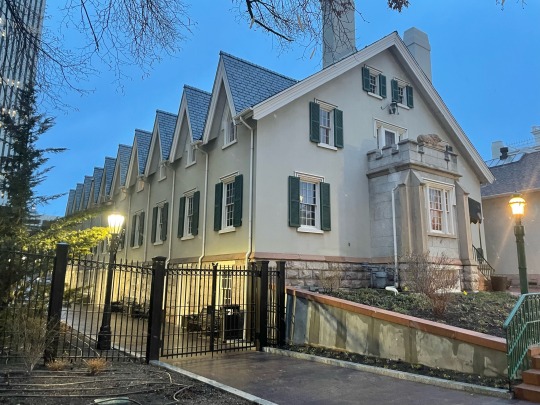

next stop was the Beehive House (on the right) and the Lion House (which isn’t open to the public but is right next door)—Brigham Young’s residences.
I feel very grateful that we got a tour guide who obviously knew a lot about the house and its residents and acknowledged the polygamist elephant in the room, because apparently not all of them do. The Beehive House was BY’s official residence as church president, where he had his office and personal bedroom and hosted visitors. The Lion House was where most of his wives lived—each window was a separate apartment with a wife’s bedroom and one for her children, with communal rooms for cooking and eating. There are 14 separate apartments. I actually did not know that there was one wife that lived in the Beehive House permanently—I knew that some wives lived separately, but apparently Lucy Decker Young (BY’s first plural wife) was the “official hostess” (according to our tour guide, his legal wife Mary Ann was shy and didn’t enjoy hosting) and lived in the Beehive House along with her seven kids. I feel like this gave me a bit more to ponder about with the family dynamic—it must have been a bit odd for Lucy’s children to be the only ones living full time under the same roof as their father, though of course their dozens of half-siblings were right next door.

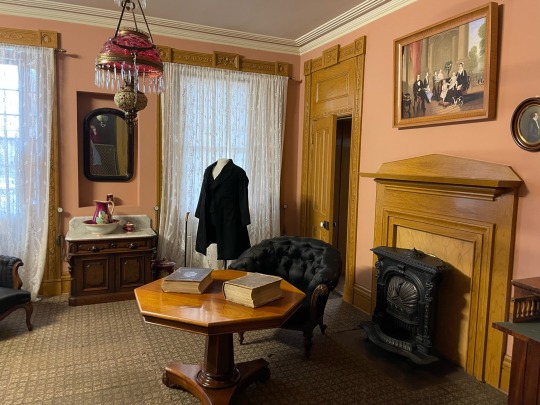
Brigham’s bedroom

Lucy’s bedroom (the doll on the little chair belonged to her youngest child, Clarissa, born in 1860)
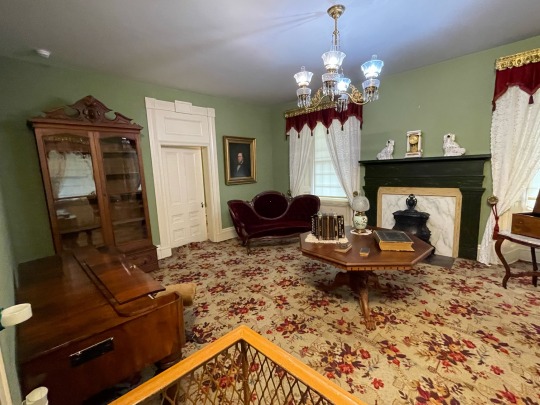

Smaller downstairs sitting room and larger upstairs “long hall”. The carpets are not original but the furniture is, apparently. The children’s bedrooms are not furnished but apparently the girls slept on the second floor, which was heated in the winter but stifling in the summer, and the boys slept in the attic, which was cold in the winter, and on the roof in the summer.
This is most of the Young-era Beehive House (dining room and kitchen are closed rn), but there was a later addition that I’ll discuss in a reblog!
#our tour guide was overall good but she was def Very Mormon in a lot of respects. she was like Brigham Young didn’t have servants but he#would hire new arrivals to Utah and they’d work in the house for room and board and he called them ‘the men and girls who work with us’ not#servants. like personally I for one would prefer being paid no matter what you called me screeeeam#Mormonposting tag#julia in utah 2023
15 notes
·
View notes
Text
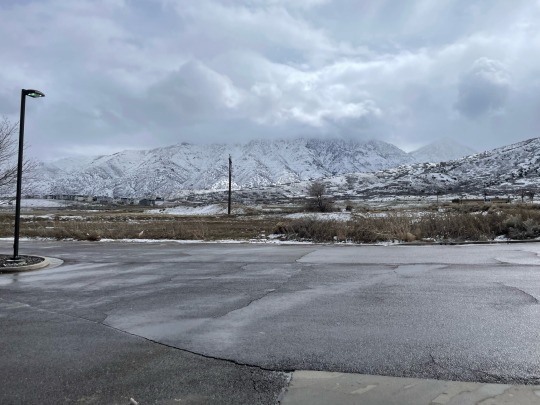
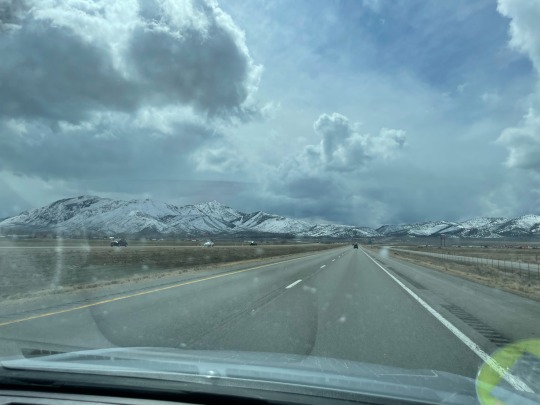
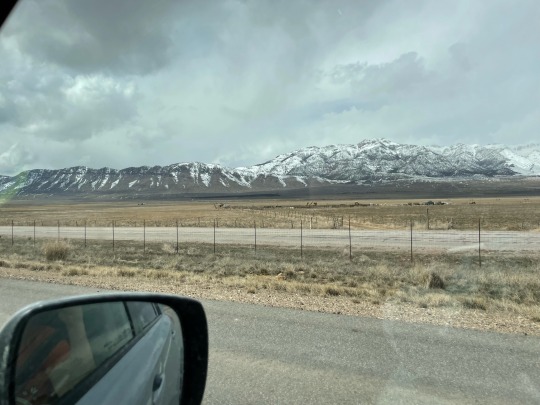
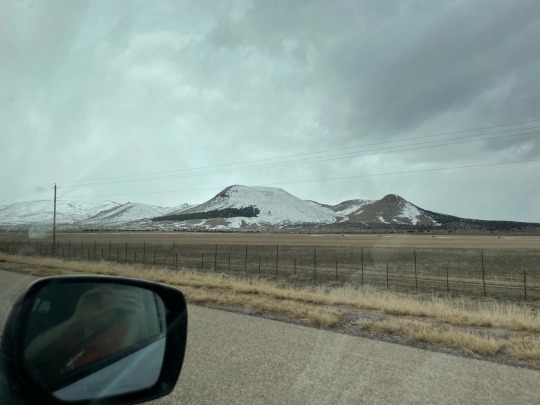
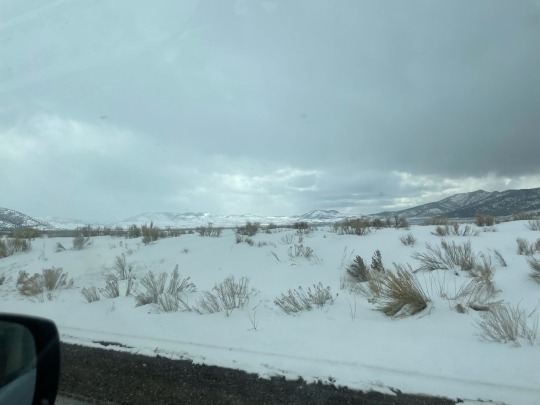
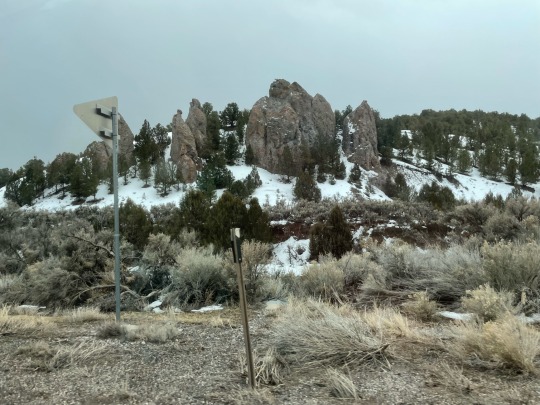
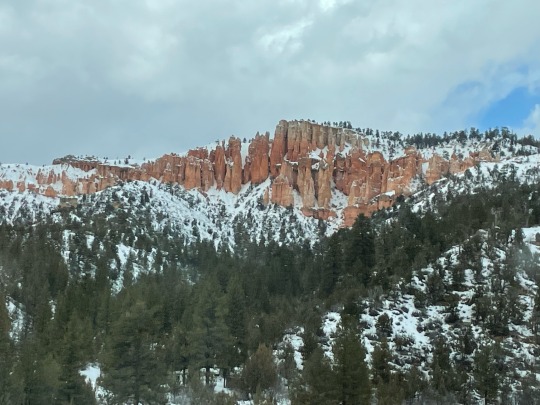
salt lake —> zion
#we are in our cabin making chili and tomorrow…we hike#it was snowing so a 4 hour drive became like a 7 hour drive#Julia in Utah 2023
12 notes
·
View notes
Text

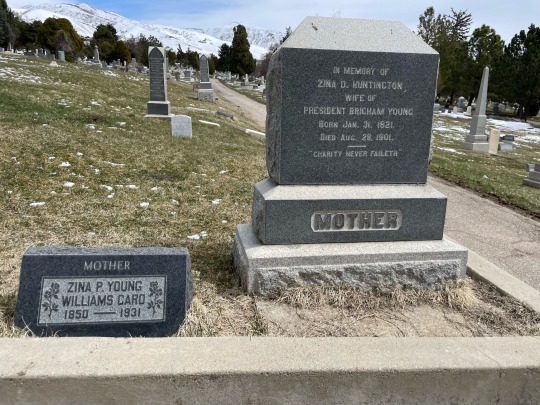

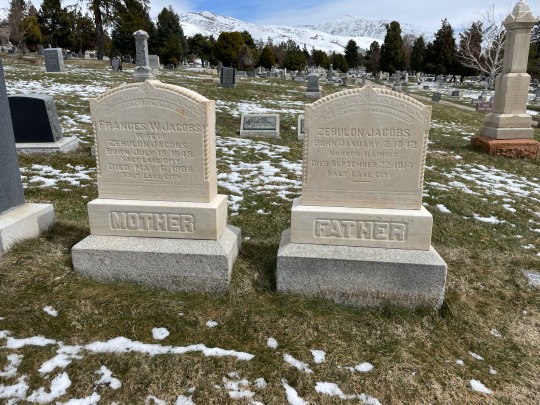
I mentioned Zina Huntington earlier while talking about the graves of Brigham Young's wives, but I wanted to make a separate post for her, in part because she is buried separately, and buried in a very unique setting that reflects the unique marital circumstances of her life.
Born as Zina Diantha Huntington in New York, she converted to Mormonism along with her parents and siblings when she was fourteen. Throughout her life, Zina was known for the zeal of her religious faith, including her gift with speaking in tongues. Shortly after her family's arrival in Nauvoo when she was eighteen, she and her mother both became severely ill with malaria. Her mother died, but Zina recovered in Joseph Smith's house, being taken care of by Emma and the Smiths' daughter Julia. They became close. Zina began a courtship with a young Mormon man named Henry Jacobs, but at the same time Joseph Smith began teaching her about plural marriage in secret. He proposed to her three times, but she continued rejecting him, and accepted Henry's proposal instead. Joseph agreed to officiate the marriage but then cancelled last-minute, so they got another officiant. Several months later, Zina, now expecting her first child with Henry and continuing to be pressured by her prophet, began feeling guilty and afraid she had disregarded God's will. She was sealed in secret to Joseph Smith by the end of the year. It's unclear whether Henry knew about this at the time. Several of Joseph Smith's plural wives also had legal husbands (this is referred to as a polyandrous marriage), though this practice fell out of favor once polygamy became open doctrine in Utah.
After Joseph's assassination, Zina, like several of his other plural widows, was sealed to him again with Brigham Young standing as proxy, and to Brigham Young for time. By this time, Henry knew about the sealing, because he attended it, but he may have thought this was a marriage in name only. She continued to live with him, had a second child, and left Nauvoo for Utah with him. Later, when he was sent back East on a mission (the latest of several he had been ordered to serve, leaving him frequently absent from Zina), she began living with Brigham Young. Henry, heartbroken after returning from his mission to find himself estranged from his family, wrote several letters over the next few years begging her to take him back and to be reunited with his sons, but it's unclear what or if she responded.
Historically, we can only guess at Zina's feelings about Henry or why she chose to leave him for Brigham Young. Later in life, she referred to her first marriage as unhappy, but in the same discussion she deliberately misrepresented the timeline to make it seem like she was briefly married to him before Joseph Smith, rather than a longer marriage overlapping with her polygamous ones. She may have felt ashamed of or self-conscious about the polyandrous aspect of her marriages, and she generally seems to have been very unwilling to discuss the matter. We also don't know what element religious coercion played in her choices here. She did continue to mark Henry's birthday in her diary throughout her life, with some private affection. Finally, she chose to be buried in the Jacobs family plot near him, alongside their two shared sons and her daughter with Brigham Young, though they had not lived together for decades. Defining her family, as with many polygamist women, may have been both complicated and emotionally thorny for Zina. I, personally, am also inclined to sympathize with Henry. Though we don't know all the emotional circumstances of the breakup of their marriage, his letters about missing his children are really upsetting, and I don't think he deserved to lose his family the way he did. (He did re-establish a relationship with his sons when they were older.)
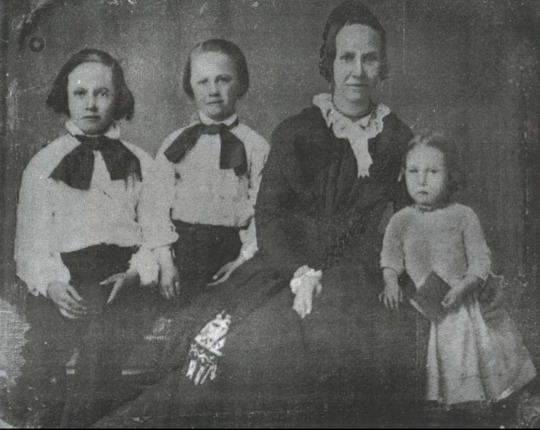
Zina with her children, Zebulon and Chariton Jacobs and Zina Young.

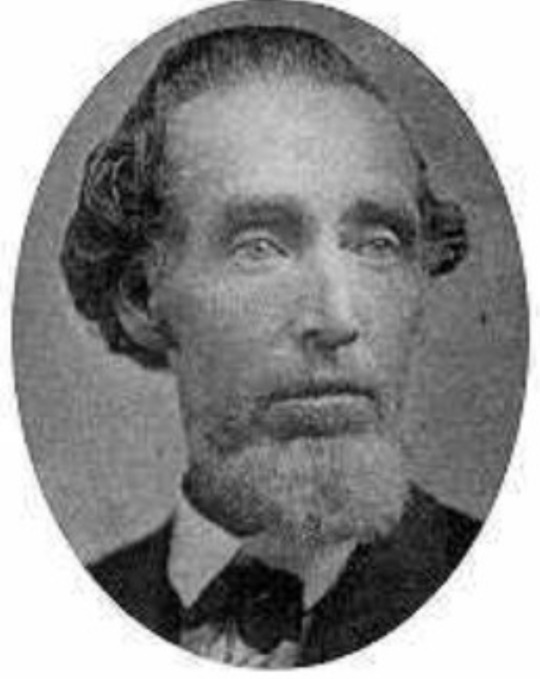

Zina and Henry Jacobs later in life; Zina with her daughter and namesake granddaughter.
Aside from the rather sad, messy story of her marriages and family, Zina had a very full life, one of the most well-known and widely respected Mormon women of her era. I mentioned earlier that she was known for her spiritual gifts--she was also a renowned nurse and midwife, and combined both skills by bestowing blessings for healing to sick or pregnant women. (For those of you who don't know a lot about Mormon theology, this is interesting in part because female-to-female blessings and spiritual practice was pretty widespread in 19th century Utah but is discouraged in the modern church, in favor of male priesthood authority). Zina seems to have been both a caring person and a natural leader, generally well-loved by her sister-wives and with a broad circle of friends. She was also active in Utah's suffrage movement and served as counselor to Relief Society President Eliza Snow, her friend and sister-wife. It was remarked that they complemented each other well, because Eliza was a cerebral intellectual and Zina was much warmer and more caring. After Eliza died in 1887, Zina succeeded her as Relief Society President and served in that capacity until her own death.

Here, Zina (far left) is photographed with friends Bathsheba Bigler Smith, Emily Partridge Young, and Eliza Snow. Emily and Eliza were both Zina’s sister-wives twice over, having been married to Joseph Smith and then Brigham Young. (Note: I’m using both maiden and married names for most women but only Snow for Eliza because that was what she went by even after her marriage, while other contemporary women usually switched to their married surname).
I think I'd like to leave this by remarking on the quote chosen for Zina's gravestone: "Charity Never Faileth". I think it really encapsulates her life. Though she definitely experienced a lot of complications and struggles, some of which we'll never know the whole story of, I think Zina also found a lot of meaning and joy in both communal bonds with other women and public service. I also think that since she only had three children and they all outlived her, she may have avoided by accident of fate some of the hardship and tragedy that many of her contemporaries experienced with constant childbearing and repeated child loss. Her life seems like it was less frankly bleak than some of the other women in her circle I've written about here, and I'm happy for her about that, though she went through enough as it is. Back to the quote: it reminded me a little bit of the one chosen for Clara Decker Young, "blessed are the peacemakers". These quotes that very much aligns with 19th century Mormon expectations of feminine attributes, but they're also deeply compelling.
#i hope you're getting my point in the last paragraph like...there were sad elements of her life but i think she found more peace than emily#partridge or helen kimball and i dont think that reflects poorly on any of them. anyway just my opinion.#julia in utah 2023#mormonposting tag
10 notes
·
View notes
Text
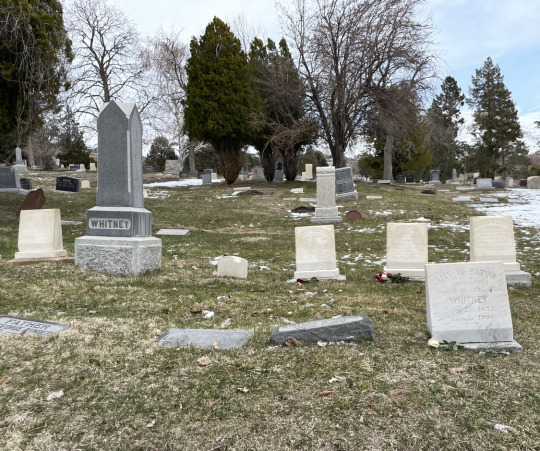
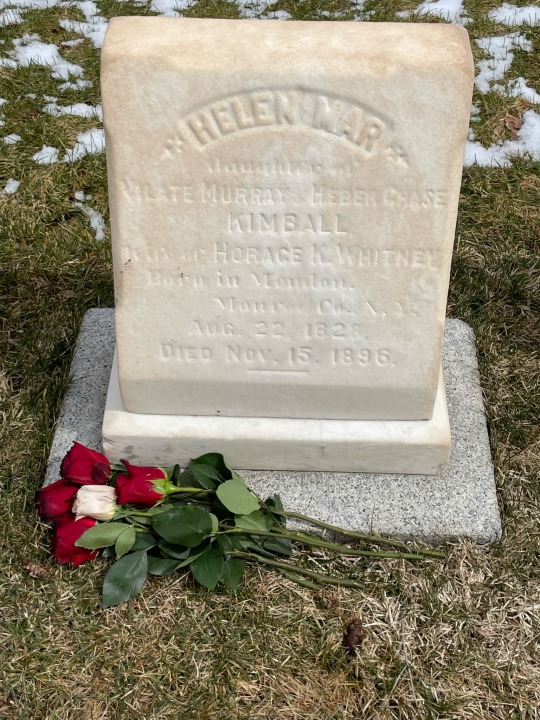


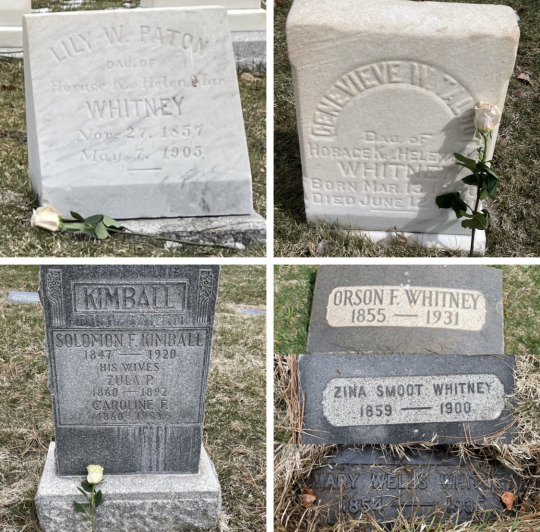
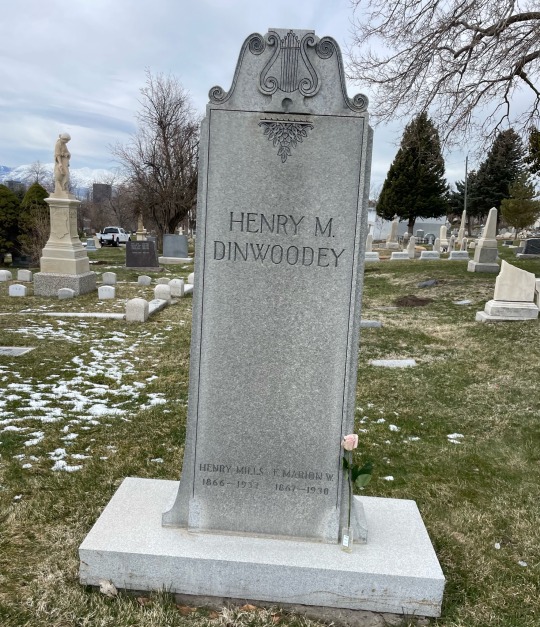
One of the graves I most wanted to visit was Helen Mar Kimball Whitney: Helen was an avid diarist, and I've read about 800 pages of her diary entries recorded mostly over the last decade of her life after her husband died, so I feel like I "know" her from her writing. She also has a very poignant and frankly pretty upsetting life story, and I wanted to pay my respects to her.
Helen was the oldest daughter of early church leader Heber Kimball, and the only surviving daughter he had with his first wife, Vilate. Helen's parents converted to Mormonism when she was three years old. When she was five, her family relocated to Kirtland, Ohio, where the church was then headquarted, and where Heber was ordained as one of the original Quorum of the Twelve Apostles. When Helen was fourteen, her life dramatically changed when her father took a plural wife and then arranged a marriage between his daughter and 37-year-old Joseph Smith. Helen was his youngest wife. A little more than a year later, she became a fifteen-year-old widow after Smith's assassination. Helen's later in life reflections of this period mingle memories of her teenage unhappiness with an adult perspective of religious piety and duty, which is reflected by contemporary letters from her father urging Helen to be obedient through trials in search of promised spiritual blessings.
Later, seventeen-year-old Helen married Horace Whitney, the older brother of her best friend Sarah Ann, who she had apparently had a crush on since before her first marriage, right before they left Nauvoo for Utah along with the majority of the church. Settling in Salt Lake City, Helen and Horace had eleven children, six of whom survived to adulthood. Eventually, Horace married again, and Helen lived in a house next to her sister-wife, Mary Cravath Whitney. Helen struggled significantly with chronic physical health issues beginning in her late teens, starting with difficult pregnancies and births. She also suffered from what she described alternately as issues with her nerves, melancholy, "deathly spells", and demonic attacks. Because of her disabling psychological and physical health issues, she often felt that she was not able to socialize or engage with her hobbies the way she wanted to. In her early teens, Helen had sung in the Nauvoo church choir, played piano, and had several roles in amateur theater productions. Horace, who played the violin, was also artistic, and their children were involved in music and theater as well. Her main creative outlet as an adult seems to have been writing--in addition to her prolific and vivid diary entries, she published articles and poetry in Mormon women's magazines, as well as two pro-polygamy pamphlets.
Helen experienced a lot of loss and trauma in her life, from the pressures of her early marriage to the deaths of several of her children in infancy. A little more than a year after the death of her husband, the family went through another tragedy: her younger son, Charlie, who was 21, killed himself. Helen struggled with both grief and shock at the nature of his death for the rest of her life. Another thing that drew me to the Whitney family gravesite was wanting to document Charlie's headstone. According to his mother's diary, he was buried next to his father, but there was no information on FindAGrave and I thought the headstone might no longer be extant. Thankfully, I was able to photograph Charlie's simple headstone and I will be creating a page on FindAGrave for him.
I'm very glad that I was able to see Helen and her family and leave flowers: her diary was very moving to me and I have a lot of sympathy for her. She seems like she was a very intelligent, talented woman who dealt with a lot of really difficult, crushing things in life, and I wish she hadn't had to. Especially given how much grief she experienced and that I know she hoped to reunite with her family in heaven, it was sort of comforting to see them all buried together, and the Whitney section is very beautiful.
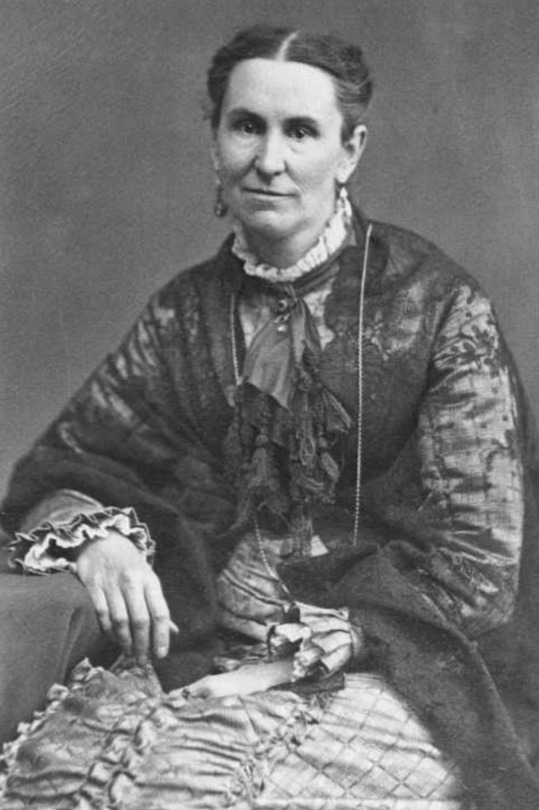


The top image is Helen as an older woman. Middle is Horace and Mary. The bottom picture is her five surviving children, son Orson and daughters Lily, Genevieve, Florence, and Helen (clockwise from left). This picture was taken after Charlie died, I don't think there are any pictures of him. I was able to find the graves of every Whitney child except Helen--the area where she and her husband are supposed to be buried is kind of not in good repair and I suspect if the graves were in-ground plaques they may have grown over--you can see that one of Orson's wives had grown over and I had to kind of dig out her plaque. Charlie, Lily, and Genevieve are buried in the same plot as their parents, along with several half-siblings from Horace and Mary's marriage. Florence is with her husband's family, as is Helen (allegedly, as I wasn't able to locate the grave). (She's also named on the grave as F. Marion, though her family did not call her by her middle name. Maybe later in life.) Orson is buried with his wives in a different part of the cemetery next to his uncle, Solomon Kimball, who was Helen's youngest full brother whom she was very close to. (Note: Solomon was a widower who remarried, not a polygamist. Orson, on the other hand, had two wives at the same time).
#mormonposting tag#julia in utah 2023#sorry for making the longest post of all time. appreciate her. and my studies.
10 notes
·
View notes
Text
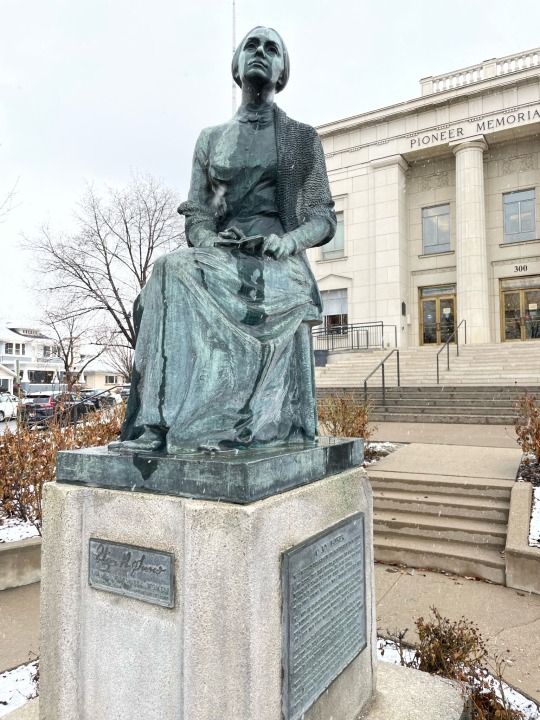
our first stop the first morning in Salt Lake City was the Daughters of Utah Pioneers museum, which was an absolute treasure trove to me—magnificent collection of 19th century material history from the everyday to the obscure, focusing especially on women’s and children’s belongings and handicrafts. It isn't as polished or curated as the church-run museums, but you can tell a lot of love went into compiling the collection, as well as constructing a lot of the objects on display. I took probably hundreds of photos but here are some of my favorite little exhibitions:



pretty much all the furniture and items in this display room belonged to members of the Kimball family—as someone who is working on furnishing a Victorian era dollhouse it was really cool to see everything.
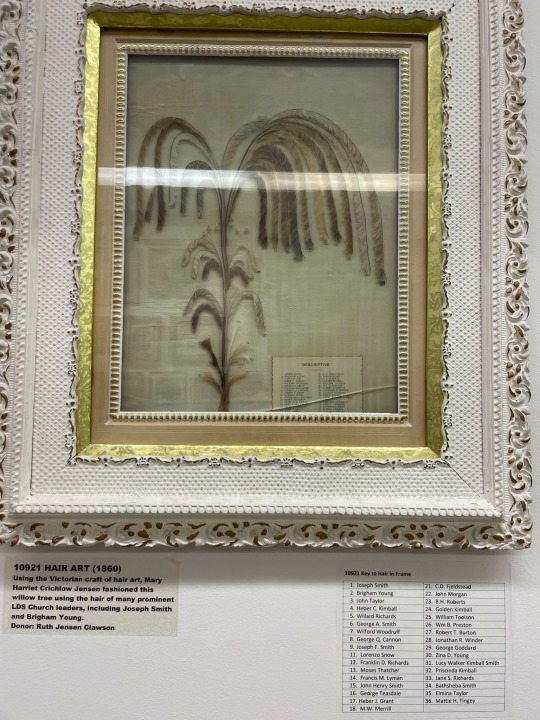

hair art was a popular Victorian craft, going way beyond just having your spouse’s hair in a locket. The first piece offers a unique Mormon twist, containing hair from more than thirty prominent church members.

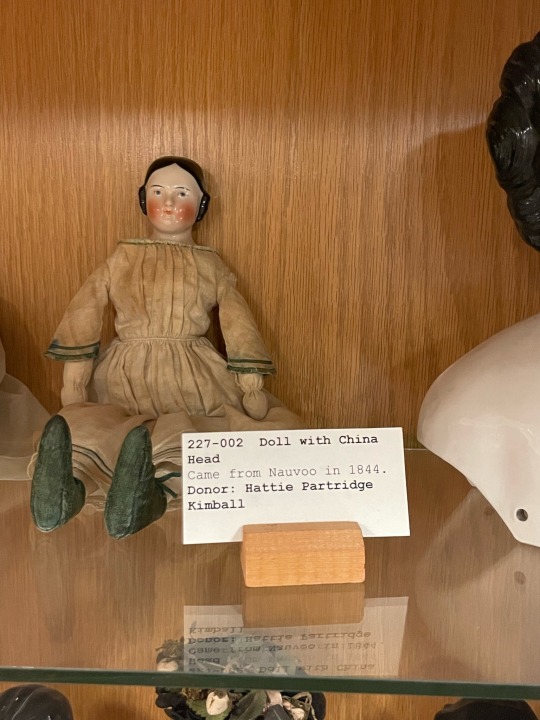
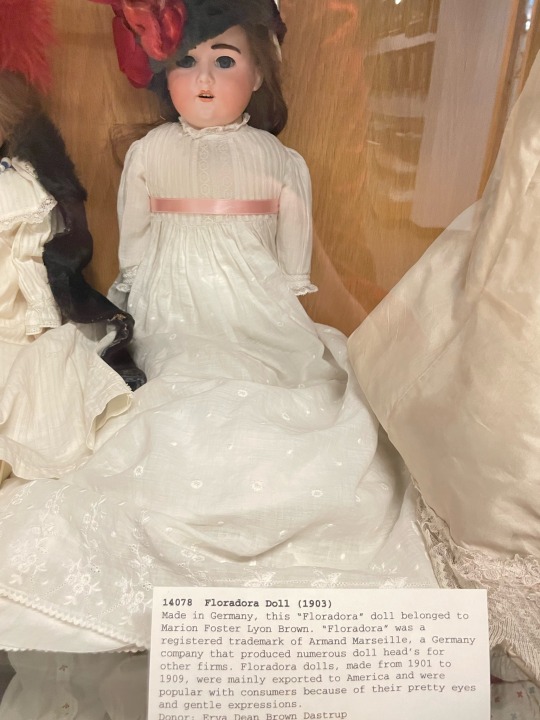
The doll room was a particular favorite of mine, featuring literally hundreds of 19th century dolls: I can post more if people are interested! There were a few dolls that made the trip all the way from Nauvoo to Utah along with the earliest Mormon settlers. I'd previously read about Helen Kimball Whitney bringing her favorite childhood doll with her as a young married woman and found that very touching. Whether these dolls traveled with little girls or with adult women, their people must have loved them very much to bring them on a difficult journey when space was at a premium.
I've reached the image limit, so I'll reblog with a few more museum highlights!
12 notes
·
View notes
Text

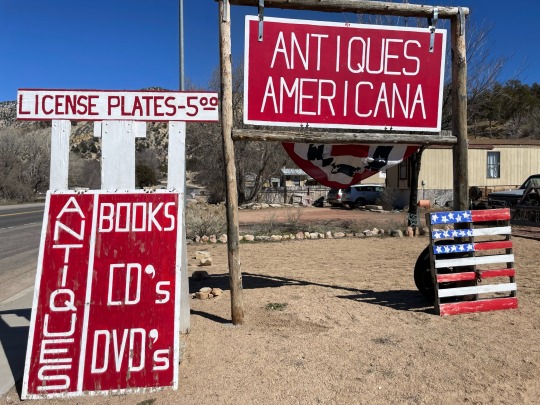



Orderville—former home of a 19th century Mormon compound, current home of a whole lot of antique books
#I was obsessed w the antique store you literally rang the buzzer and this man came out his house next door and let us into what was#essentially a large shed full of cool old books and random junk. god bless#I purchased 2 vintage cookbooks a book about Mormon quilting and the RLDS Joseph Smith translated Bible for nine dollars#NO idea how a RLDS book ended up in Utah#Julia in Utah 2023
17 notes
·
View notes
Text
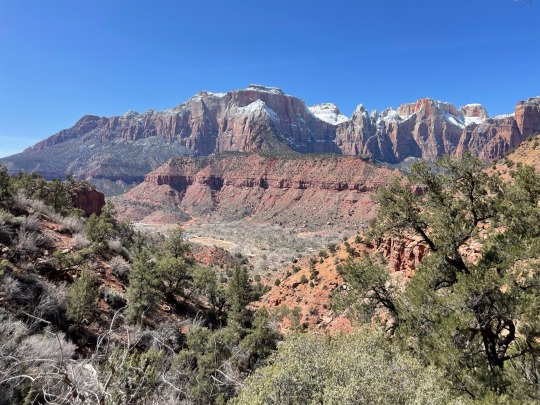
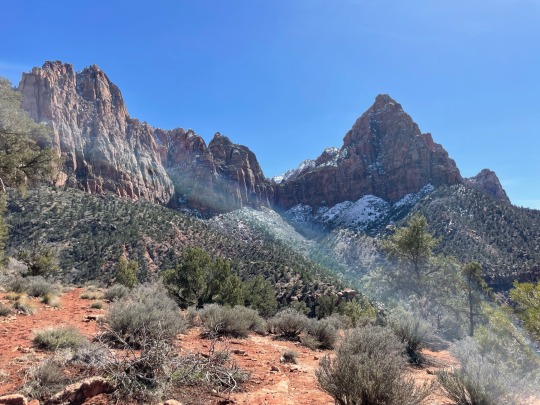
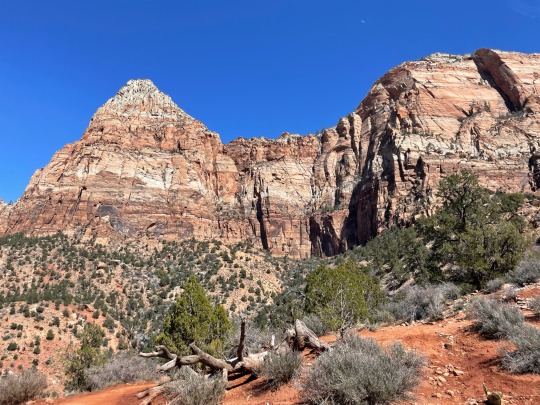

the watchman, zion
#w the sort of pale orange rock and gray plants I felt like I was walking through a sepia photo!#Julia in Utah 2023
9 notes
·
View notes